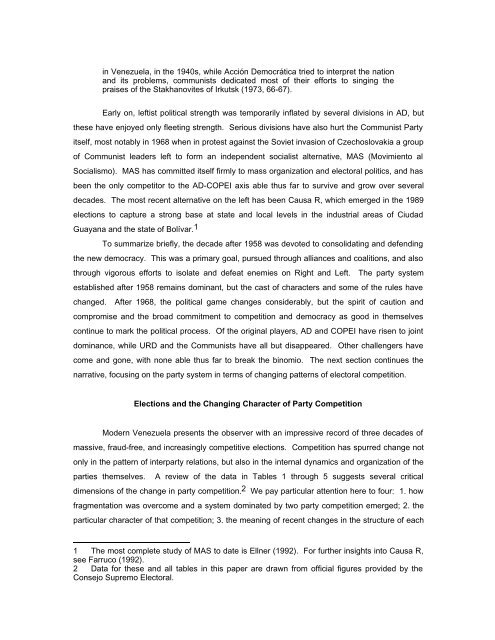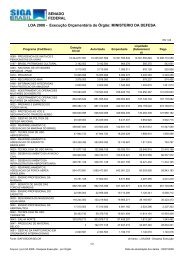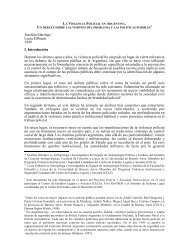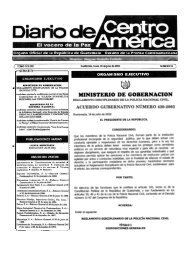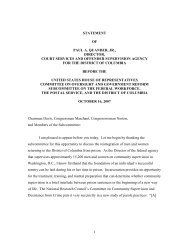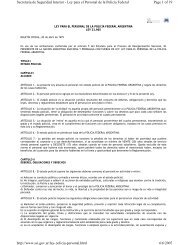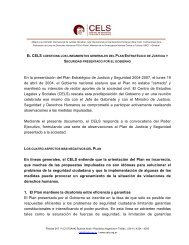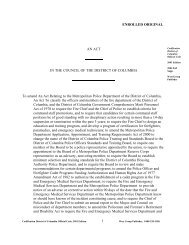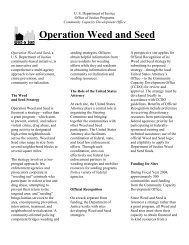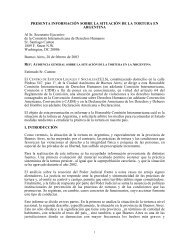Venezuela: The Life and Times of the Party System - Political ...
Venezuela: The Life and Times of the Party System - Political ...
Venezuela: The Life and Times of the Party System - Political ...
You also want an ePaper? Increase the reach of your titles
YUMPU automatically turns print PDFs into web optimized ePapers that Google loves.
in <strong>Venezuela</strong>, in <strong>the</strong> 1940s, while Acción Democrática tried to interpret <strong>the</strong> nation<br />
<strong>and</strong> its problems, communists dedicated most <strong>of</strong> <strong>the</strong>ir efforts to singing <strong>the</strong><br />
praises <strong>of</strong> <strong>the</strong> Stakhanovites <strong>of</strong> Irkutsk (1973, 66-67).<br />
Early on, leftist political strength was temporarily inflated by several divisions in AD, but<br />
<strong>the</strong>se have enjoyed only fleeting strength. Serious divisions have also hurt <strong>the</strong> Communist <strong>Party</strong><br />
itself, most notably in 1968 when in protest against <strong>the</strong> Soviet invasion <strong>of</strong> Czechoslovakia a group<br />
<strong>of</strong> Communist leaders left to form an independent socialist alternative, MAS (Movimiento al<br />
Socialismo). MAS has committed itself firmly to mass organization <strong>and</strong> electoral politics, <strong>and</strong> has<br />
been <strong>the</strong> only competitor to <strong>the</strong> AD-COPEI axis able thus far to survive <strong>and</strong> grow over several<br />
decades. <strong>The</strong> most recent alternative on <strong>the</strong> left has been Causa R, which emerged in <strong>the</strong> 1989<br />
elections to capture a strong base at state <strong>and</strong> local levels in <strong>the</strong> industrial areas <strong>of</strong> Ciudad<br />
Guayana <strong>and</strong> <strong>the</strong> state <strong>of</strong> Bolívar. 1<br />
To summarize briefly, <strong>the</strong> decade after 1958 was devoted to consolidating <strong>and</strong> defending<br />
<strong>the</strong> new democracy. This was a primary goal, pursued through alliances <strong>and</strong> coalitions, <strong>and</strong> also<br />
through vigorous efforts to isolate <strong>and</strong> defeat enemies on Right <strong>and</strong> Left. <strong>The</strong> party system<br />
established after 1958 remains dominant, but <strong>the</strong> cast <strong>of</strong> characters <strong>and</strong> some <strong>of</strong> <strong>the</strong> rules have<br />
changed. After 1968, <strong>the</strong> political game changes considerably, but <strong>the</strong> spirit <strong>of</strong> caution <strong>and</strong><br />
compromise <strong>and</strong> <strong>the</strong> broad commitment to competition <strong>and</strong> democracy as good in <strong>the</strong>mselves<br />
continue to mark <strong>the</strong> political process. Of <strong>the</strong> original players, AD <strong>and</strong> COPEI have risen to joint<br />
dominance, while URD <strong>and</strong> <strong>the</strong> Communists have all but disappeared. O<strong>the</strong>r challengers have<br />
come <strong>and</strong> gone, with none able thus far to break <strong>the</strong> binomio. <strong>The</strong> next section continues <strong>the</strong><br />
narrative, focusing on <strong>the</strong> party system in terms <strong>of</strong> changing patterns <strong>of</strong> electoral competition.<br />
Elections <strong>and</strong> <strong>the</strong> Changing Character <strong>of</strong> <strong>Party</strong> Competition<br />
Modern <strong>Venezuela</strong> presents <strong>the</strong> observer with an impressive record <strong>of</strong> three decades <strong>of</strong><br />
massive, fraud-free, <strong>and</strong> increasingly competitive elections. Competition has spurred change not<br />
only in <strong>the</strong> pattern <strong>of</strong> interparty relations, but also in <strong>the</strong> internal dynamics <strong>and</strong> organization <strong>of</strong> <strong>the</strong><br />
parties <strong>the</strong>mselves. A review <strong>of</strong> <strong>the</strong> data in Tables 1 through 5 suggests several critical<br />
dimensions <strong>of</strong> <strong>the</strong> change in party competition. 2 We pay particular attention here to four: 1. how<br />
fragmentation was overcome <strong>and</strong> a system dominated by two party competition emerged; 2. <strong>the</strong><br />
particular character <strong>of</strong> that competition; 3. <strong>the</strong> meaning <strong>of</strong> recent changes in <strong>the</strong> structure <strong>of</strong> each<br />
1 <strong>The</strong> most complete study <strong>of</strong> MAS to date is Ellner (1992). For fur<strong>the</strong>r insights into Causa R,<br />
see Farruco (1992).<br />
2 Data for <strong>the</strong>se <strong>and</strong> all tables in this paper are drawn from <strong>of</strong>ficial figures provided by <strong>the</strong><br />
Consejo Supremo Electoral.


